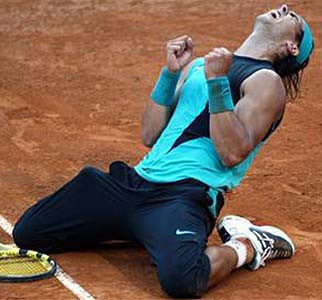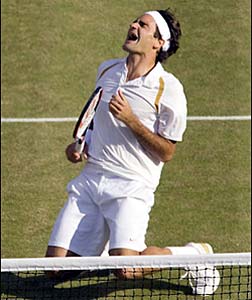|
TennisOne Lessons Winning On-court Habits for Match Play Ray Brown and Jana vd Walt It is well known that there is a clear difference in performance between play and practice. While there are many factors that contribute to these differences, in this article we will discuss on court habits that can make a significant difference in the outcome of your matches. On-court habits are learned behaviors that you must internalize and use without thinking. Any hesitation in your actions can lead to an unforced error or to a breakdown in your discipline with an associated loss of confidence. These habits are related to the mental side of the game, but are different in that they are physical actions that can be practiced in the same manner that one practices strokes. In this sense, they lie between the mental game, in that they are mental habits, and the physical stroke production, in that they are physical actions. Always assume the ball is coming back. Novice players often lose points by assuming their "great shot" is a winner. Against good play, you should assume the ball is coming back. Failing to do so leads to more than loss of a point. It may also diminish your confidence, a more serious problem that is hard to recover from.
Never stop running for the ball until it bounces twice. Another mental mistake is to assume you cannot get to a ball and so you let up before it has bounced twice. The only way to know for sure that a ball is unreachable is to make every effort to reach it. Frequently, you will be surprised to find that it was reachable after all. An additional benefit is that your opponent may be intimidated by your determination and begin over hitting shots as a direct result of your effort. Anger is your enemy, except when channeled constructively. Few players can play when angry. This is a direct result of how the normal human brain is wired or constructed. The fact that human visual processing can be affected by anger (you have heard the term " a blind rage") is significant. In particular, focal vision can be reduced by anger, making it very difficult to see the ball precisely enough for a clean hit. You must function without presuppositions or preconceived ideas or biases. Many players approach the game with preconceived ideas about how it should be played. It is a bit surprising that this even occurs at the professional level among the lower ranked players, but not the higher ranked players. For an example, one can find players who refuse to hit a moon ball or push the ball when it is a winning strategy. Needless to say, this is not a point-of-view that brings in an income at the professional level. There are many players stuck in the range of 300-500 on the wta tour ranking lists who just can't get past their preconceived ideas of how the game should be played. The dynamics of a tennis ball are a matter or the laws of nature, not the emotions or opinions of players. No matter how you might prefer the game to unfold, it will not unfold according to a pattern that fits your preconceived ideas or preferences for shot making, so you must adapt your point-of-view to the game and not expect that the game will adapt to your point-of-view, that is if you prefer to win. Get a good start by keeping it simple. At the outset of any match, both players are nervous because there is a great deal of uncertainty about the outcome. It is interesting that unforced errors committed in their first four games can determine the outcome of the entire match. And, among all errors that can affect the outcome, the 'first-ball' error is the most serious. These occur often when a player attempts to draw on their best shots in the early going. First-ball errors are a confidence killer, and as noted above, if your confidence is shaken, it is hard to recover. One conventional professional approach is to keep your decisions and shot selection as simple as possible in the early going to reduce the possibility of first-ball errors. In general, rallying cross court or down-the-middle for the first four games, until you reach a comfort level, can build confidence even if you lose the first four games. I recall a 35 year old player I entered in the Baltimore City Open Championships and instructed her to hit every ball high down the middle of the court. She won the tournament. You can beat a lot of players (and in this case much younger players with superior skills) by using a simple strategy. While it is not necessary to use such a strategy throughout a tournament, it shows the power of simplicity. I recall another player who always used a strategy of playing cross court to their opponent's strongest shots until he got familiar with their skill level. He typically lost the first four games using this approach and won the next six. The simplest thing you can do is rally cross court to your strongest side until you settle your nerves. Be careful to not change a wining game. When you get ahead in a match, it is very tempting to assume you have won. With this point-of-view, it is easy to lose. The most common mental mistake is to change your winning game and become more aggressive and take more risks. This can often lead to a series of unforced errors, a breakdown of confidence, and ultimately, the loss of their match that you were sure you had won. While it can be a bit boring to stick with a winning position until the match is won, breaking off from a wining position can be disastrous.
Jimmy Connors was once asked " When do you know you have won their match?" His answer: "When the last ball has bounced twice. " This point-of-view is frequently illustrated in a grand slam championship final when the winner falls to the court, surprised and emotionally overwhelmed by the fact that they have won. Never presume you have won. Not only is this arrogant, but it presumes you can tell the future and that you know in advance of all possible events that could change the outcome. Add more skill only after you have established confidence. Once you have established a simple start, and are making good progress, it is reasonable to ask, when do you add some more of your skill to the contest. As a general rule, after you have settled your nerves you will sense that some more skill can be introduced. The trick is to introduce more skill in small increments. For example, if you have chosen to rally cross-court, or down the middle, a simple addition would be to increase the ball speed without changing direction. An increase in ball speed of as little as 3mph can lead to a significant increase in your game score. This is a well established fact. Inexperienced coaches or players will often think they must do something dramatic to increase their advantage. This is not true. In fact, by trying to be more dramatic (to close out the match for example) one can often make the errors necessary to let your opponent back into the match. You have nothing to prove to anyone, so keep your approach disciplined and focused, avoiding temptations to put on a dramatic performance for the audience. The players most skilled at keeping it simple to win are the Williams sisters when they get into a tight battle and the outcome is uncertain. They eschew fancy shots and dramatic finishes, relying instead on a steady simplified approach to dealing with tense situations.
Play the ball that can be played. You will often find yourself thinking you would like to hit your big forehand at some point in a rally. While you should be looking for opportunities to create advantages with your skills, the art is in deciding when to do this. For example, you cannot take the approach that on the third ball you are going to hit your big forehand. There is no way to know that this can be done on the third shot. The third shot may be some unexpected short ball that clipped the net and you have to scramble to reach it. The point is that you must hit the shot that can be hit under the circumstances of the rally. Hence, you cannot rely on being able to hit your big forehand whenever you would like, but only when the circumstances allow it. Martina Hingis was famous for always hitting the shot that could be hit under the circumstances of the rally. To do this, you must retain a flexible and adaptable point-of-view throughout the match because trying to hit a shot that the dynamics and your positioning cannot support will lead to a error. Do not let the opinions of others affect your decisions. It is common to see players being affected by the opinions of others. They may think that their father expects them to play a certain way, or their friends are watching and waiting for them to do something dramatic. If you let the opinions of others get into your head, you will make errors. You cannot play a match from the point-of-view of others. They are not on the court; you are and you must make all the decisions unassisted. Whatever anyone else thinks must be irrelevant to your game. One ball at a time. Matches are won one point at a time and points are won one ball at a time. The most important ball is the one you must hit at the present moment. Living in the present is a key to success in tennis. It is a real time sport in which you must make a decision about every three seconds. This is very rare in sports in general. While racquet ball and table tennis are similar in this respect to tennis, the complexity and physical demands occurring at the moment decisions must be made in tennis are far greater than for any other sport. Even in boxing you can delay a decision. Not in tennis. You must make a decision when the ball arrives, no later. This is one reason it is so easy to make an error in tennis. There is very little you do in your everyday life that requires such a stream of quick decisions. Hence, losing touch with the present for a fraction of a second can result in an error.
Avoid answering speed with speed. It is tempting to answer a fast ball with a fast ball. This is an ego reflex and must be avoided. There is only so fast one can hit a ball before it will go out. Therefore, you must develop the facility to take speed off the ball as well as to add speed to the ball. Get your ego out of the point. This is a delicate point. You have a stake in the point and therefore your ego is involved. But how is the complex question. There are countless ways the ego can get involved, some productive, some counter productive. If you are thinking about being a big deal with dramatic shots, then your ego is going to produce errors. If you get caught up in short term thinking such as can be brought on by anger, you are likely to make errors. If you can focus on being steady, making good decisions, and maintaining your intensity, then you can win matches and tournaments. It is a constant balancing act that you must maintain to keep focused and involved and not get sidetracked by petty annoyances. Things that can assist you are having respect for the game and your opponent and understanding that it is still a game you are playing, and losing is not the end of the world. Control your heart rate and blood pressure. Heart rates and blood pressure, as we have pointed out else where, can approach those of mortal combat in tennis. If these two factors reach critical levels, the result will be a series of unforced errors. Breathing techniques are necessary to employ to manage these autonomic factors. However, many players have developed rituals to control heart rate and blood pressure. The ritual dance of Sharapova between points comes to mind in this respect. In summary, there are many routine things one can do to improve their chances of winning. Among these are to develop good court and match play habits. Doing so will eliminate the most common source of unforced errors. Your comments are welcome. Let us know what you think about Ray Brown's article by emailing us here at TennisOne.
Ray Brown is the founder of EASI Tennis®. The EASI Tennis®System is a new and revolutionary method of teaching stroke technique that can dramatically reduce the time needed to learn to play master, or any level, of tennis. To learn more about the EASI Tennis® System, click here.
Over the past fifteen years Ray has been working in the area of neuroscience and brain dynamics and its application to tennis training. During this time, he has conducted extensive experiments in conjunction with his wife to develop scientifically advanced tennis skill and conditioning programs Ray is currently a WTA/ITF Challenge Circuit Coach, the girls Head Coach at TJ High School in Alexandria, VA and a teaching pro in Annandale, VA. Ray also administers an advanced training certification program (EASI), see http://www.easitenniscertification.com/. Dr. Brown received his Ph.D. in mathematics from the University of California, Berkeley in the area of nonlinear dynamics and has over 30 years of experience in the analysis of nonlinear systems. He has published over 40 articles on tennis coaching and player development and over 35 scientific papers on complexity, chaos, and nonlinear processes. |



 Ray Brown, Ph.D.
Ray Brown, Ph.D.